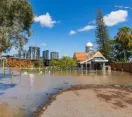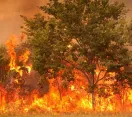Find information on understanding your flood risk, preparing for flooding, recovering after a severe weather event, and Council's flood plans, policy and projects.
Types of emergencies
Brisbane's subtropical climate means our city is prone to severe weather events, a variety of natural disasters and hazards. It is common for Brisbane to experience a number of different severe weather events including:
- flooding from a number of different sources, e.g. river, creek, overland flow, king tide and storm surge
- severe storms with hail and damaging winds
- heavy rainfall
- bushfires
- earthquakes, heat waves, landslides, dust storms
Find what you need
Other types of disasters
Cyclone
Cyclone
Tropical cyclones are low pressure systems that form over warm tropical waters and have gale force winds near the centre. They occur between November and April.
Cyclones are dangerous because they produce destructive winds, heavy rainfall with flooding and damaging storm surges that can cause inundation of low-lying coastal areas.
Heavy rainfall associated with the passage of a tropical cyclone can produce extensive flooding.
Be prepared
Before summer it is best to be prepared for any severe weather by completing Brisbane City Council's home readiness checklist.
Approaching storm or cyclone
As a storm or cyclone is approaching:
- listen to your local radio/TV station for official advice and warnings
- shelter your pets and animals
- store loose items inside (if appropriate, put outdoor furniture in your pool)
- secure doors and windows and draw curtains
- put valuables, medications, spare warm clothing etc. in plastic bags with your emergency kit
- disconnect electrical items and outside TV aerials and turn off gas
- fill bins and boats with water
- in the case of a cyclone, fuel your car and park it undercover or cover it with tied tarpaulins/blankets.
Afterwards
After the storm or cyclone has passed:
- listen to your radio and remain indoors until advised
- do not go sightseeing
- stay away from damaged power lines, fallen trees and flood water.
More information
For more information about cyclones and how to be ready before they strike, visit the Bureau of Meteorology website.
Dust storm
Dust storm
Brisbane experienced a large dust storm (the Red Dawn dust storm) in September 2009. This storm storm severely affected Brisbane's air quality and visibility. Dust storms may have an adverse effect on your health, particularly if you already have breathing-related problems.
Health effects
Particles in dust storms are normally coarse and do not pose a serious health threat to the general public. Coarse dust particles generally only reach as far as the inside of the nose, mouth or throat. Some people with pre-existing breathing problems, such as asthma and emphysema, may experience difficulties.
If you have asthma or a respiratory condition and you develop symptoms such as shortness of breath, coughing, wheezing, or chest pain, follow your treatment plan. If symptoms persist, see your doctor.
The most common symptoms experienced during a dust storm are irritation to the eyes and upper airways. Dust storms may also:
- trigger allergic reactions and asthma attacks
- cause serious breathing-related problems.
People who may be more at risk than others are:
- infants, children and adolescents
- elderly people
- people with respiratory conditions, such as asthma, bronchitis and emphysema
- people with heart disease
- people with diabetes.
Safety
Protect yourself by:
- staying indoors, with the windows and doors closed
- avoiding vigorous exercise, especially if you have asthma, diabetes or a breathing-related condition.
If you have to drive:
- reduce your speed
- pull off the road if visibility is less than 100 metres
- switch off your air conditioning to reduce the amount of dust entering your car.
More information
Earthquake
Earthquake
Seismic activity occurs from time to time in the Brisbane region but generally at such a low level that has little to no community impact. For this reason, earthquakes rate quite low as a disaster risk for our city.
On 30 July 2015, a 5.3 magnitude earthquake offshore of Eastern Queensland in the Coral Sea was felt in Brisbane. This earthquake produced multiple aftershocks, the largest of which measured 5.7 on the Richter scale. However, while a few residents reported feeling their homes shake, there was no reported damage in the Brisbane Local Government Area.
A maximum Richter magnitude of 6.5 is theoretically possible within the region, which includes Brisbane. Such an event would be capable of generating highly damaging effects at the source but is an extremely unlikely event for Brisbane.
Brisbane City Council's Disaster Management Plan takes a comprehensive, all-hazards approach for any type of disaster or emergency event. This means that while incidents can’t be predicted in their timing or location, Council prioritises zero harm, minimising impact on residents and working toward restoring services.
More information
For more information about earthquakes, visit the Geoscience Australia website.
For more information on how to prepare for earthquakes, visit the Get Ready Queensland website.
Heat wave
Heat wave
A heat wave occurs when there are more than a few days in a row above 34 degrees, often combined with high humidity.
Stay healthy in the heat. Find out how you can prepare for and cope during a heat event with these simple tips:
- drink two to three litres of water per day, even if not thirsty
- wear lightweight, light-coloured, loose, porous natural fibre clothes
- avoid strenuous activities
- don't drink alcohol, soft drinks, tea or coffee - they worsen dehydration
- don't take salt tablets unless prescribed by a doctor
- avoid heavy protein foods (e.g. meat, dairy products) which increase body heat and fluid loss
- keep your home cool with curtains, shutters or awnings on the sunny sides and open windows at night
- if you don't have air conditioning, use fans, damp clothing and have frequent cool showers
- spend as much time as possible in air-conditioned buildings (e.g. shopping centres, galleries, museums)
- avoid direct sunlight - wear a hat and sunscreen as sunburn limits your ability to cope with the heat
- if you work outside, keep hat and clothing damp
- don't leave children or pets in parked vehicles
- if you suffer chronic illness or feel ill, see a doctor
- keep animals in the shade with plenty of water.
Although everyone is vulnerable to the effects of a heatwave, those most at risk are:
- children under four years of age
- older people
- people with a chronic condition or illness
- overweight people
- people who undertake vigorous exercise.
Look after yourself, but also check on sick or frail friends, neighbours and relatives.
Hot cars
Never leave a child or a pet alone in a hot car. On a typical Australian summer day, the temperature inside a parked car can be as much as 30 to 40 degrees higher than the outside temperature. That means on a 30-degree day, the temperature inside the car can be as high as 70 degrees.
More information
For more information about heat waves, visit the Queensland Government website.
Landslide
Landslide
Landslides usually involve the movement of large amounts of either earth, rock, sand or mud or any combination of these. Landslides can be caused by earthquakes, volcanoes, soil saturation from rainfall or seepage or by human activity (e.g. vegetation removal, construction on steep terrain).
More information
For more information about landslides, visit the Queensland Government website.

